Are you a Quiet Speculation member?
If not, now is a perfect time to join up! Our powerful tools, breaking-news analysis, and exclusive Discord channel will make sure you stay up to date and ahead of the curve.
Brace yourself: the Modern Pro Tour is coming. Between the Oath of the Gatewatch exposition, StarCityGames' Regional blowout, and Super Bowl Sunday, I'm going to be glued to a screen for every waking weekend hour. Will Affinity, Burn, and Grishoalbrand run riot in Atlanta? Can Von MIller's defense stuff Cam Newton's offense on the Levi's Stadium turf? Is Wizards' Splinter Twin ban gambit going to save or sink the Modern metagame? What new insane Modern speculation target will spike into orbit? By the time you check back in on Monday morning, we'll still be recovering from Saturday's and Sunday's festivities, but at least we'll know the answers to those questions. Today, we'll make a final survey of the Twinless metagame to see how Modern is taking shape on the eve of Pro Tour Oath.
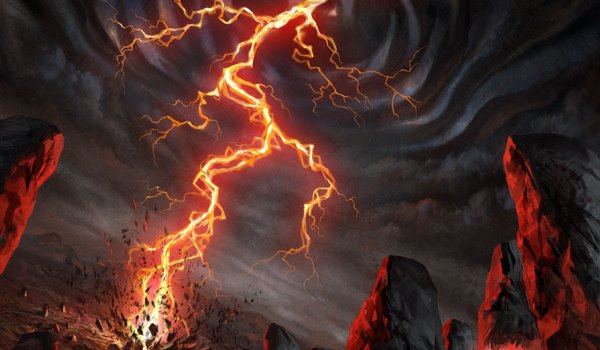
While professing my love for Shape Anew on Monday, I also promised a return to the metagame numbers used to inform last week's "Early Snapshot" article. I'm delivering on that pledge today, having more than doubled our dataset on both the paper and MTGO fronts. On the MTGO end, we're up to 16 events and about 200 decks. Paper brings just over 30 tournaments and 280 lists to the analysis. As Blake Rasmussen quipped in today's Daily Magic Update, the community is obsessively "studying Modern results like they're the Rosetta Stone." Guilty as charged, Mr. Rasmussen! Our readers would expect nothing less, which is why we're bringing you one final evidence-based look at the format before everything gets confirmed or upended over the weekend.
[wp_ad_camp_1]
Pre-Pro Tour Metagame Summary
Although I'm stoked to report our hoarded data, I can't ignore the sample's limitations. It's relatively small (about a third as many 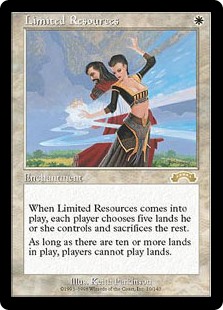 datapoints as in our usual breakdowns) doesn't cover many days (11 instead of 30-31), and hasn't included any truly major events like the upcoming Pro Tour or even an SCG Open. All of these factors exert degrees of bias, and we'll want to account for that influence as best as possible before digging through the data. To emphasize a point I made last time, and in my recent Quiet Speculation article on the same topic, we shouldn't trash the entire sample just because of these complications. As long as we proceed cautiously and limit our inferences to match the sample's limitations, we can still extract a lot of value from this kind of evaluation. I'll take a 480 deck sample over a purely hypothetical population in any analysis!
datapoints as in our usual breakdowns) doesn't cover many days (11 instead of 30-31), and hasn't included any truly major events like the upcoming Pro Tour or even an SCG Open. All of these factors exert degrees of bias, and we'll want to account for that influence as best as possible before digging through the data. To emphasize a point I made last time, and in my recent Quiet Speculation article on the same topic, we shouldn't trash the entire sample just because of these complications. As long as we proceed cautiously and limit our inferences to match the sample's limitations, we can still extract a lot of value from this kind of evaluation. I'll take a 480 deck sample over a purely hypothetical population in any analysis!
Mindful of these constraints, I'm laying out all three tables for all three tiers, offering preliminary projections of where decks are settling in the new Modern. Unlike in our previous, more standardized metagame article, I'll be replacing the Day 2 prevalence column with Round 0 metagame shares. These numbers draw from three tournaments that were kind enough to share what decks got registered before the action began. Final note: I'm tweaking the weighted average method we usually use to account for an overall reduced sample, which will play out in the "Overall Metagame %" column. As usual, you can check out the raw dataset on the Top Decks page.
Less stats babble, more Modern! Here's an early look at where things are shaping up in Modern. We start with Tier 1, the Modern decks you can expect to play against at major tournaments. Tier 1 comprises about 44% of the format.
Tier 1: Pre-Pro Tour
Tier 2 is up next, showcasing tournament-viable decks you might not necessarily encounter at any given event. They still show competitive teeth, however, which makes them fine choices for your upcoming SCG Regionals. Making up 31% of the format, Tier 2 combines with the Tier 1 picture to showcase just over 75% of Modern.
Tier 2: Pre-Pro Tour
Finally, we end with Tier 3, a new classification bracket I'm introducing in 2016. These fringe decks are neither regular tournament highlights nor necessarily viable strategies at every event. Despite their outsider status, they remain strong metagame calls depending on specific Tier 1 and Tier 2 options you encounter en route to the top tables. I'm still refining Tier 3's statistical criteria, so pardon our dust while we sharpen the system. Today, Tier 3 adds another 8.4% to the Tier 1 and Tier 2 shares, bringing us to about 83% of the format represented in these three tables.
Tier 3: Pre-Pro Tour
There's a lot to digest in these almost 30 rows of decks and data, so take a Moment's Peace to Absorb all of the numbers again. While you're at it, send positive vibes towards Wizards to reprint both those cards in 2016 Modern-legal sets.
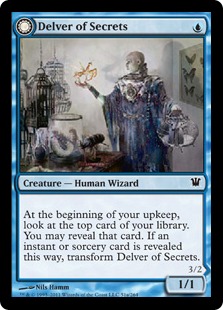 Admitting our earlier limitations, I'm not going to say much about Tier 3 other than a) all of these decks could be more or less viable depending on how the weekend shakes out, and b) it's probably much wider than the table suggests. If you've boxed up Goblin Electromancer, Intangible Virtue, or Delver of Secrets for Regionals or the Pro Tour, don't start emptying sleeves yet! Wide-open Modern fields like the one we see today benefit players who know their decks and who make smart metagame calls. If Sun Titan control fits that profile for you, then bring your Mortarpods and Pilgrim's Eyes with confidence. At this stage more than usual, the data speaks more heavily to deck popularity and visibility than to performance and viability. Keep that in mind when parsing any of today's results.
Admitting our earlier limitations, I'm not going to say much about Tier 3 other than a) all of these decks could be more or less viable depending on how the weekend shakes out, and b) it's probably much wider than the table suggests. If you've boxed up Goblin Electromancer, Intangible Virtue, or Delver of Secrets for Regionals or the Pro Tour, don't start emptying sleeves yet! Wide-open Modern fields like the one we see today benefit players who know their decks and who make smart metagame calls. If Sun Titan control fits that profile for you, then bring your Mortarpods and Pilgrim's Eyes with confidence. At this stage more than usual, the data speaks more heavily to deck popularity and visibility than to performance and viability. Keep that in mind when parsing any of today's results.
Now that we've oriented ourselves to the dataset, I'm going to turn to the Tier 1 standings. These decks offer us the least ambiguous and most actionable marching orders as we head into Saturday. Once we've picked the Tier 1 data-tree clean, we'll move on to Tier 2 for some more general takeaways.
Early Tier 1 Observations
I know you've memorized all the metagame shares listed above (quick: which deck had the highest MTGO share? No Peeking!), but for those with more important facts to memorize, here's the table again before we dive into the data. Pay close attention not only to the individual decks and their discrete shares, but also how those decks line up with other Tier 1 players and how those individual shares compare with one another.
Tier 1: Pre-Pro Tour
For me, the keys to understanding the current Tier 1 are grouping similar archetypes, looking at relative magnitudes, and checking numbers against theory. We'll leverage all three of those analytical lenses as we identify a few overall themes in today's Tier 1 showings.
Meeting Expectations...
Collectively, the Tier 1 table gives a lot of credence to linear characterizations of Modern. The big three decks are the same overall as in 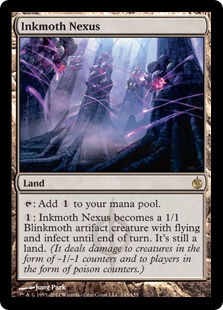 paper: Affinity, Burn, and Tron, all in an identical order. Everyone from Pascal Maynard to the average Redditor expected this scenario, and it's largely played out in the paper scene. Although MTGO shuffles the decks around and mixes in a few curveballs, Tron is still king and Burn and Affinity are less than 2% behind. Eldrazi joins the ramp party, and although Blight Herder is more midrange muscleman than a turn three Karn Liberated, this deck's rise was another widely held expectation for post-ban Modern. Not to be outdone by the main linear three, Infect sneaks aboard the standings to add another lightning fast contender into the Modern big leagues. In sum, these expected Tier 1 players make up 34% of the whole format.
paper: Affinity, Burn, and Tron, all in an identical order. Everyone from Pascal Maynard to the average Redditor expected this scenario, and it's largely played out in the paper scene. Although MTGO shuffles the decks around and mixes in a few curveballs, Tron is still king and Burn and Affinity are less than 2% behind. Eldrazi joins the ramp party, and although Blight Herder is more midrange muscleman than a turn three Karn Liberated, this deck's rise was another widely held expectation for post-ban Modern. Not to be outdone by the main linear three, Infect sneaks aboard the standings to add another lightning fast contender into the Modern big leagues. In sum, these expected Tier 1 players make up 34% of the whole format.
We saw many of these linear forces at play in last week's article, and it's statistically encouraging that our observed trends held stable after doubling our previous dataset. This suggests the default Level 0 belief really 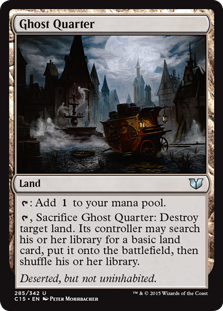 was a good one: players flocked to many of the decks we believed they would. Because this theorized scenario played out so cleanly in the early data, we can be more comfortable trying to "Next Level" out of this particular baseline. Found a deck with capable Tron, Affinity, and Burn matchups? Those qualifications alone might make it tournament-viable. Can't figure out your sideboard? You can do a lot worse than tailoring your board for these five expected decks (the big three plus Infect and Eldrazi). Our Level 0 point of departure is one reason I'm catching the Jeskai bug: between Lightning Bolt, Electrolyze, and Ghost Quarter, I'm feeling very secure against this field. Still feeling week in your main 60? Don't forget your sideboard! A pinch of Crumble to Dust and a dash of Kitchen Finks go a long way towards shoring up Game 1 weaknesses.
was a good one: players flocked to many of the decks we believed they would. Because this theorized scenario played out so cleanly in the early data, we can be more comfortable trying to "Next Level" out of this particular baseline. Found a deck with capable Tron, Affinity, and Burn matchups? Those qualifications alone might make it tournament-viable. Can't figure out your sideboard? You can do a lot worse than tailoring your board for these five expected decks (the big three plus Infect and Eldrazi). Our Level 0 point of departure is one reason I'm catching the Jeskai bug: between Lightning Bolt, Electrolyze, and Ghost Quarter, I'm feeling very secure against this field. Still feeling week in your main 60? Don't forget your sideboard! A pinch of Crumble to Dust and a dash of Kitchen Finks go a long way towards shoring up Game 1 weaknesses.
As David cautioned last Tuesday, be careful trying to craft the anti-deck, lest you end up Next Leveling yourself into wielding scissors in a field of rock. Words of wisdom notwithstanding, the Level 0 expectation was a safe one, and you can feel just as safe brewing or metagaming your way through it. Prioritize Tron, Affinity, and Burn, stay mindful of Eldrazi and Infect, and you'll be off to a great start for the weekend.
...and Challenging Assumptions
Many Modern personalities and players were so committed to prophesying the linear apocalypse that they discounted interaction altogether. Last week's data exposed some latent strengths for two much more interactive decks. This week's analysis all but confirms it. Community members counted them down and out, but trusty Merfolk and trustier Jund have shown enough early promise in the new Modern to get them preliminary Tier 1 status. Our job is to understand how they got there and assess whether they are likely to stay.
Swimming in last for MTGO (4.5%), but a much more respectable fourth in paper (6.5%), Merfolk is surfing the change in true Master of the Pearl Trident style. Merfolk has always been Tier 1 or Tier 2 in our 2015 Nexus breakdowns, so it shouldn't come as a shocker that the fish 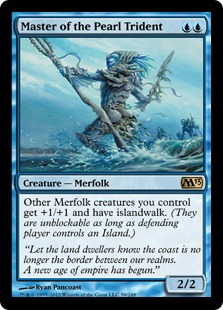 returned in an unknown metagame. Or maybe it should. After all, Merfolk lost its favorable Twin matchup and now needs to navigate Affinity and Infect-ridden seas. At first pass, these pressures might appear to be too much for the mermen to handle. Fortunately for King Trident's team, other metagame factors more than compensate for these weaknesses. Look back to the Level 0 decks above. Affinity and Infect are rough, but Tron and Eldrazi are a day at the beach. Burn is a close 50-50 that plays out both ways, but you have more flexibility in taking the control reins or buckling into the driver's seat to race. Comparing shares for those opposing decks, you're at least breaking even on matchups in Tier 1. Add all the random pickups you get against Tier 2 or lower strategies and it's no wonder Merfolk has distinguished itself in post-Twin Modern.
returned in an unknown metagame. Or maybe it should. After all, Merfolk lost its favorable Twin matchup and now needs to navigate Affinity and Infect-ridden seas. At first pass, these pressures might appear to be too much for the mermen to handle. Fortunately for King Trident's team, other metagame factors more than compensate for these weaknesses. Look back to the Level 0 decks above. Affinity and Infect are rough, but Tron and Eldrazi are a day at the beach. Burn is a close 50-50 that plays out both ways, but you have more flexibility in taking the control reins or buckling into the driver's seat to race. Comparing shares for those opposing decks, you're at least breaking even on matchups in Tier 1. Add all the random pickups you get against Tier 2 or lower strategies and it's no wonder Merfolk has distinguished itself in post-Twin Modern.
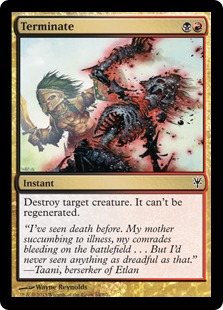 Jund is a much more fascinating case deserving more analysis. Writing in the ban's immediate aftermath, Neal Oliver proclaimed Jund "the biggest loser under the new bannings." Willy Edel made a similar, although more measured, appraisal in his BGx article today, warning "that Jund is poorly positioned" in the current metagame and to "try stock Jund at your own risk." The overall community also agreed. In the almost two weeks between those articles, numerous Modern players have taken to forums, Reddit, and comment sections to agree with these statements, decrying the inevitable Eldrazi and linear takeover which would surely Terminate Jund's, and BGx's, chances to regulate a new Modern.
Jund is a much more fascinating case deserving more analysis. Writing in the ban's immediate aftermath, Neal Oliver proclaimed Jund "the biggest loser under the new bannings." Willy Edel made a similar, although more measured, appraisal in his BGx article today, warning "that Jund is poorly positioned" in the current metagame and to "try stock Jund at your own risk." The overall community also agreed. In the almost two weeks between those articles, numerous Modern players have taken to forums, Reddit, and comment sections to agree with these statements, decrying the inevitable Eldrazi and linear takeover which would surely Terminate Jund's, and BGx's, chances to regulate a new Modern.
Preliminary numbers suggest the exact opposite has happened. Jund has thrived on MTGO, where it is the third most-played deck behind the two strategies that should have killed it: RG Tron and Bx Eldrazi. In  paper, Jund lags behind the big linear three and Merfolk, but has actually picked up metagame share above Ulamog's minions and the Infectious swarm. I know what some of the more skeptical Modern analysts are thinking: in the two weeks following a big banning, players (especially in paper) lack time and resources to ditch one deck and play another. If true, this would mean Jund's 6.6% metagame share from December would naturally contribute to January's 5.1%, representing a loss of about 1.4% between the months. I don't buy this for a second and you shouldn't either. Another BGx deck, Abzan, was pre-trending to overtake Jund at the end of December after leaping 2.3% from its November high. Where is Abzan today? Sputtering in Tier 2 at 2.4%, practically its lowest share since we started tracking metagame numbers and well below its 5.2% December prevalence. Assuming both BGx pilots had invested comparable capital into both strategies, it is exceedingly unlikely that Jund mages were too steeped in the sunk cost fallacy to switch decks, while Abzan mages nimbly jumped ship. That is, unless the metagame dictated which one was better positioned.
paper, Jund lags behind the big linear three and Merfolk, but has actually picked up metagame share above Ulamog's minions and the Infectious swarm. I know what some of the more skeptical Modern analysts are thinking: in the two weeks following a big banning, players (especially in paper) lack time and resources to ditch one deck and play another. If true, this would mean Jund's 6.6% metagame share from December would naturally contribute to January's 5.1%, representing a loss of about 1.4% between the months. I don't buy this for a second and you shouldn't either. Another BGx deck, Abzan, was pre-trending to overtake Jund at the end of December after leaping 2.3% from its November high. Where is Abzan today? Sputtering in Tier 2 at 2.4%, practically its lowest share since we started tracking metagame numbers and well below its 5.2% December prevalence. Assuming both BGx pilots had invested comparable capital into both strategies, it is exceedingly unlikely that Jund mages were too steeped in the sunk cost fallacy to switch decks, while Abzan mages nimbly jumped ship. That is, unless the metagame dictated which one was better positioned.
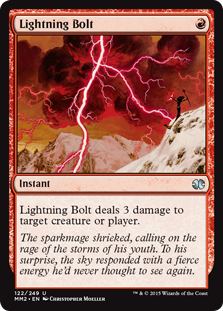 Given this metagame context and the numbers, we can comfortably challenge the myth of Jund's death. I'm personally unsurprised. Jund boasts an impressive battery of answers to the Level 0 decks. Lightning Bolt trumps Abzan's Path to Exile against Affinity, Infect, and Burn. Blackcleave Cliffs saves you at least a Shock in matches that come down to the wire. Dark Confidant reloads against decks that can't reliably remove him on turn two. Although both BGx options bring Fulminator Mage and Ghost Quarter to the ramp fray, Jund picks up a major edge by allying Mage with Kolaghan's Command in the maindeck and Crumble to Dust/Blood Moon in the board.
Given this metagame context and the numbers, we can comfortably challenge the myth of Jund's death. I'm personally unsurprised. Jund boasts an impressive battery of answers to the Level 0 decks. Lightning Bolt trumps Abzan's Path to Exile against Affinity, Infect, and Burn. Blackcleave Cliffs saves you at least a Shock in matches that come down to the wire. Dark Confidant reloads against decks that can't reliably remove him on turn two. Although both BGx options bring Fulminator Mage and Ghost Quarter to the ramp fray, Jund picks up a major edge by allying Mage with Kolaghan's Command in the maindeck and Crumble to Dust/Blood Moon in the board.
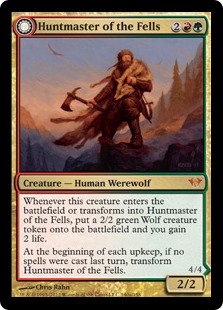 Abzan supporters are going to point to the relative strengths of Lingering Souls, Siege Rhino, and sideboard bullets like Stony Silence as a reason for their deck's superiority, but this has not played out in the numbers. It doesn't even play out in theory. Kitchen Finks/Huntmaster of the Fells/Kalitas, Traitor of Ghet do a passable Rhino imitation in key matchups and Jund's board has as many (if not more) strengths than Abzan's can claim. White's Path is undeniably strong, but red's Bolt is better in most matchups. Terminate can pick up the pieces. The statistical context makes these comparisons even more favorable to Jund. As a whole, all of this suggests an early edge for Jund which I expect Bob and Tarmogoyf to maintain. It also makes a convincing case for which cards you should be playing if you aren't sure what else to do. Brian DeMars is on the same page too!
Abzan supporters are going to point to the relative strengths of Lingering Souls, Siege Rhino, and sideboard bullets like Stony Silence as a reason for their deck's superiority, but this has not played out in the numbers. It doesn't even play out in theory. Kitchen Finks/Huntmaster of the Fells/Kalitas, Traitor of Ghet do a passable Rhino imitation in key matchups and Jund's board has as many (if not more) strengths than Abzan's can claim. White's Path is undeniably strong, but red's Bolt is better in most matchups. Terminate can pick up the pieces. The statistical context makes these comparisons even more favorable to Jund. As a whole, all of this suggests an early edge for Jund which I expect Bob and Tarmogoyf to maintain. It also makes a convincing case for which cards you should be playing if you aren't sure what else to do. Brian DeMars is on the same page too!
Projecting past the weekend, I see different futures for both Merfolk and Jund. If 2015 is any indication, 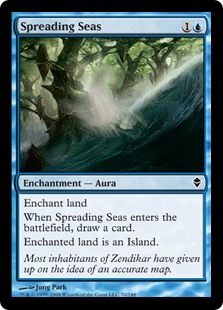 Merfolk's share is likely to drip back into Tier 2, and the deck will bounce between the two brackets for much of the New Year. The fishies pick up a lot of metagame relevance due to the Eldrazi and Tron matchups where Spreading Seas can dominate, but as these decks ebb (and Affinity/Infect flow), Merfolk's fortunes will see parallel ups and downs. Jund is going to experience similar movement, but always in the context of whether it's better to sling Bolts and Commands or pack Paths and Souls. Perhaps the bigger takeaway is not necessarily Jund's superior metagame position now, even though early numbers do suggest this conclusion. Rather, it's that BGx as an archetype has yet again proven its resilience and adaptability in new metagames, and you can continue to expect the midrange presence in Tier 1.
Merfolk's share is likely to drip back into Tier 2, and the deck will bounce between the two brackets for much of the New Year. The fishies pick up a lot of metagame relevance due to the Eldrazi and Tron matchups where Spreading Seas can dominate, but as these decks ebb (and Affinity/Infect flow), Merfolk's fortunes will see parallel ups and downs. Jund is going to experience similar movement, but always in the context of whether it's better to sling Bolts and Commands or pack Paths and Souls. Perhaps the bigger takeaway is not necessarily Jund's superior metagame position now, even though early numbers do suggest this conclusion. Rather, it's that BGx as an archetype has yet again proven its resilience and adaptability in new metagames, and you can continue to expect the midrange presence in Tier 1.
Early Tier 2 Observations
Between our quantitative datapoints and the qualitative narratives, it's much easier to tell the Tier 1 story going into the weekend despite our limited sample. Tier 2 defies this analysis. There's almost too much format volatility to settle on the topmost decks, let alone pin down the metagame periphery in Tier 2. This makes it hard to articulate meaningful conclusions about Tier 2, other than to agree that Modern is unusually open.
Tier 2: Pre-Pro Tour
The more we look at these decks, the messier Modern starts to seem. Scapeshift and Jeskai Control take a 5.6% share for reactive strategies. Grishoalbrand and Ad Nauseam carve out 4.7% for goldfish combo. We get traditional midrange in Abzan's 2.4%, which we can line up alongside Abzan Company's and Kiki Chord's net 5.4% for fair strategies with a combo finish. Death and Taxes can join that party too, which brings the total  for nonlinear and interactive Tier 2 decks to around 15%. Not to be outdone, Bogles, Naya Company, Elves, Gruul Zoo, and others team up at 16.4% for the less interactive, more linear alternatives.
for nonlinear and interactive Tier 2 decks to around 15%. Not to be outdone, Bogles, Naya Company, Elves, Gruul Zoo, and others team up at 16.4% for the less interactive, more linear alternatives.
Many of us will feel a strong impulse to tease out every statistical relationship and nuance in these Tier 2 numbers. I'm certainly tempted! At this juncture, however, we need to resist that urge. At best, our sample limitations introduce too many variables and disclaimers into this kind of examination for it to be meaningful. At worst, they prohibit the analysis outright. Instead of getting bogged down in comparing Abzan's 2.4% share to Abzan Company's 3.1% (hint: a .6% difference in Tier 2 is meaningless when there are seven decks spanning that gap), I'm just going to reel out three quick-hit takeaways for Moderners who want to pioneer new terrain in Tier 2.
- All Tier 2 decks are about equally viable
Because the relative magnitudes between different Tier 2 decks are so tiny, and because the overall sample is smaller than usual, you can comfortably take any of these strategies to a tournament and expect some measure of success. Remember not to trap yourself into getting ahead of people who are themselves getting ahead of the metagame. This Next Level thinking ends with you going 0-3 drop on UW Control in a series of Eldrazi, Infect, and Tron matchups. If your Tier 2 baby is Jeskai Control, Abzan, or Living End, box that bad boy up on Friday night. That said, if you know something about your local metagame that we don't (e.g. the two sisters who both bring Soul Sisters to every event), adjust your Tier 2 preferences accordingly.
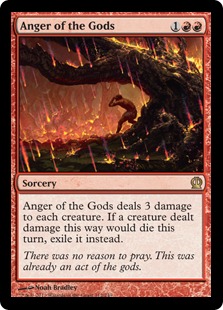 Don't try building your deck to beat every individual Tier 2 opponent
Don't try building your deck to beat every individual Tier 2 opponent
It's hard enough to prepare for the three Level 0 matchups. You saw the chaos that is Modern's current Tier 2! Do you really want to try and fix all of your bad matchups in a mere 75 slots? It's not worth the effort, the testing, the frustration, and the eventual disappointment. Instead of throwing in bullets for every matchup, group the decks and look for overlap. For instance, Death and Taxes, Elves, Gruul Zoo, and the Company decks loathe sweepers. Anger of the Gods is ready and waiting in your trade binder. That said, unless you can include at least three decks into one set, don't worry about every feasible grouping. This isn't Worlds, so don't run Hallowed Burial just to ruin the Bogles pilot's day (as fun as that feels).
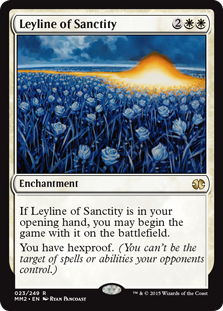 Learn what every Tier 2 deck does
Learn what every Tier 2 deck does
You can't sideboard for every Tier 2 deck. You can know what they do. Learn core synergies, general strategy lines, and standard sideboards. Death and Taxes has Flickerwisp. Gruul Zoo has Atarka's Command. Bogles and Ad Nauseam will sideboard in Leyline of Sanctity playsets. Chord of Calling decks will create all sorts of problems with instant-speed Burrenton Forge-Tender, Spellskite, Eidolon of Rhetoric, etc. Grishoalbrand is going to splice Through the Breach and Goryo's Vengeance onto other cards and will win with Pact of Negation triggers on the stack. This isn't an exhaustive list of scenarios you may encounter, but if you had to mouse-over any of those cards or scratch your head about any of those decks, do some research before wading into this current field.
Anything Can Happen!
Peyton Manning might throw more interceptions than Jay Cutler, or Derek Wolfe might smash every one of Cam Newton's runs. The Pro Tour Top 8 might be nothing but Urza's lands and Inkmoths, or Jeskai and Jund might Lightning Bolt their way to a win. In both cases, we have some early indicators of how these major showdowns will reach their riveting conclusions, and in both cases, anything can happen. With the Iowa caucus defying pollsters and predictions, it's already a week to crunch numbers and challenge takeaways. As long as Super Bowl 50 has solid football and palatable commercials, and as long as I see at least one ramp player get Ghost Quartered out of the match, I'll have a happy weekend.
Thanks for reading and I hope you enjoyed our last-minute look at the metagame stats before the big weekend rolls around. Got questions? Got predictions? Got a bone to pick with the numbers, explanations, or metagame picture? I'll see you in the comments and see you next week as we sift through the post-Pro Tour and Regionals debris.






What do you think of the dredgevine deck.
It’s a solid Tier 3 player if you can dodge Relic decks (Tron/Eldrazi/Merfolk) and if BGx isn’t doing something crazy like 4 Leyline of the Void in their board. If those conditions aren’t present, the deck becomes much worse and is only playable if you get lucky with matchups or are insanely experienced at piloting it. I think there are better aggressive options in Tier 1 and Tier 2. That said, if you think you can dodge the graveyard hate, it’s an excellent Tier 3 option which can tear apart an unprepared metagame.
EDIT: While writing another comment, I realized I wanted to add to this one.
Unlike Grishoalbrand and Living End, the upside to a successful Dredgevine strategy isn’t as powerful as the upside to the other options. Grishoalbrand just wins on turn two if unconstested. It even has a significant non-graveyard Plan B (many would argue that the graveyard is actually the Plan B itself!). Living End is slower than a fast Dredgevine start, but so much more consistent. It even packs in better interaction! I think all of these factors are also at play in Dredgevine’s struggles and, more generally, the issues other graveyard decks face.
Encore! Encore! I admire your work ethic for this site; you are posting 3 articles a week AND crunching the numbers. Best site ever!
Glad you’ve enjoyed the flurry of articles! I always love doing the metagame articles, and it’s great to see others enjoy reading them as much as I have fun writing them.
You guys put out a lot of good content, I thoroughly enjoy every article you put out. They are well reasoned and researched, and supported with evidence. This is the highest quality of content available for modern as far as I can see. Keep it up!
B/x Eldrazi is there as Tier 1, but: Which version? I’m very confused on that front.
Also, I’m not surprised that Abzan fell off the map, having Crumble to Dust seems huge for B/G/X and other Midrange decks like Temur Delver, Kiki Chord and even Jeskai on this meta.
“Bx” includes all versions: Mono-B, BW, and maybe BG.
Bx Eldarzi is all over the place right now, so I’m keeping them combined in the analysis. Most of them function similarly enough that this makes sense, although as more definition arises in the coming weeks this might change.
Crumble is huge in this format, and it was a great card to come out of Battle.
Strange to see Knightfall completely drop off. The aggro plan combined with a quick instant win that protects itself is a well positioned strategy to stall aggro and instant-win against big mana decks.
Anyone have insight into why no one is playing the deck?
I suspect that all the decks playing Relic of Progenitus maindeck are to blame, though even before Eldrazi became a thing it was dropping off. Personally, I think that no one could decide on the optimal list and with Twin around there was no reason to play it, and it’s not clear that it’s better now than straight Zoo. If Eldrazi and Tron drop off some then we could see Knightfall return.
Relic is still not played widely: Even if RGtron is packing the full playset in addition to Bx Eldrazi (I’m not seeing more than 2 relic in RGtron of late), that’s still a fairly small fraction of the meta running them maindeck. /shrug, I’ll just keep spiking local events with it (more consistent than Burn for me) and just puzzle at the lack of any pros playing it.
To be fair, I have seen SOME of the Bant Knightfall lists at a competitive level, just not enough to get them into a tiering. I think a big issue here is that the metagame is too aggressive to pursue a 4+ color Knightfall option (Blue Zoo, for instance), but that the three color Knightfall lists are worse than the three color no-Knightfall alternatives. Bant Midrange is good but Naya Company is overall better. Kiki Chord plus Knightfall is strong, but stock Kiki Chord is much more consistent. I believe this is the main factor in the combo’s disappearance, but we’ll have to wait and see if that sustains into the next months.
Because it isn’t good
Thanks for the update, Sheridan. I think that this update is the latest piece of evidence to show that Jund is Modern’s Terminator (just when you think it’s dead, it gets right back up again), and that truly reactive strategies still have some life (the fact that Jeskai Control and Scapeshift are Tier 2 and Jeskai Kiki Control are not is a genuine surprise to me). I think this is a nice and diverse metagame, and while a lot needs to be further hashed out, I think it’s a promising start to post-Twin Modern (though I find myself wondering what, if any, combo deck will eventually rise to Tier 1 status).
Like some of the above posters, I find myself wondering why some graveyard-based combo decks (Griselbrand and Living End) are still alive and kicking, whereas others (namely Knightfall) have floundered. Is it all about the bandwagon effect? Or is there a categorization issue at play (some Knightfall decks are basically Zoo with the combo attached)? Or do Griselbrand and Living End just match up better against the likes of Eldrazi and Tron (who frequently pack mainboard Relics) than Knightfall? I’m curious as to what your thoughts are on this.
Side note: Based on this metagame breakdown, Merfolk decks should really be considering Chalice of the Void. It has gem against Affinity, Bogles, Burn, Delver, Eldrazi Processors, Elves, Infect, Living End, RG Tron, Storm, and maybe even Gruul Zoo. That’s roughly 46.6% of the meta (probably a bit less because not every Eldrazi deck is a Processors deck), which is most of Tier 1, and that includes more than one of Merfolk’s 50/50-to-bad matchups. Great way to tech against the field, and stay in that Tier 1 bracket.
Definitely agree that Jund is looking like the Terminator Modern needs. I wonder if the Pro Tour will play out that way, or if we’ll see Abzan make a surprise comeback.
Just as a categorization point, if a deck has the combo in it, I just sweep it into the Knightfall category. This has some disadvantages about missing what KIND of deck is using the combo, but I’d rather capture the combo’s frequency than something more granular. I think one reason for Knightfall’s absence is the relative weakness of a 4C combo shell in an aggressive metagame. Blue Zoo is just not as good as Naya Company, even with the Knightfall upside. As for Bant lists, they lack Bolt and other red cards, which gives them poor positioning even if they have a combo option Naya Company lacks. Add in graveyard hate on top of that and Knightfall has an uphill battle.
Chalice seems incredibly strong right now. Hope we see it over the weekend and hope it doesn’t spike to $50 as a result!
The question is – in how many of these matchups will Merfolk turn a slightly unfavourable, even or slightly favourable matchup further into the positive zone such that it is worth the slots over other sb card options? I’m a firm believer in playing 4x Chalice or none as you need it in your opening hand (or the first 8 or so cards to make it work properly) – this is a significant investment in your sb slots.
Affinity – you are losing this matchup anyway chalice is not going to save you.
Bogles – agreed does very good work and is needed (2.3%)
Burn – not sure that 4x Chalice is better than TB mage, dispel, pierce options, another target for there smash and/or revelry, they have tons of 2 cmc spells – surprisingly weak
Delver – I think we are so heavily favoured it makes no difference
Eldrazi – are we really bringing this in to stop discard (only half the lists run PtE atm – we dont care about 2x Map (Sea Effects, Tec Edge/Ghost Quarter) – I disagree that you want Chalice against Eldrazi
Elves – this could be effective on the draw (1.7%)
Infect – agreed does very good work and is needed (5%)
Living End – agreed does very good work and is needed (2.5%)
RG Tron – does some work (7%)
Storm – agreed does very good work and is needed (1.5%)
Gruul Zoo – suffers from all the issues that arise playing burn
My numbers come to about 20% of the meta regarding usefulness verse the rest of the field. We could argue about burn/small zoo – that would take us to less than 30% of the field – I dunno – im still not sure about Chalice in modern merfolk..
One other issue is that Chalice non-bo’s with Vapor Snag, Spell Pierce, Dispel and of course Aether Vial..
Chalice can be effective against Affinity if you set it to zero turn one on the play, but after that they’ve emptied their hand and it’s worthless at any cost. Against Burn it can be good, but only if their draw has a lot of Lava Spike and Bolt, otherwise the deck Is mostly 2 cmc cards. Chalice is very good against Delver assuming you get it in the first few turns, otherwise it’s dead and so is your opponent hopefully. It’s actually very bad against Elves, I tried it and the threatening cards cost 3 or more, don’t play Chalice against Elves, they only need one mana elf and they will ignore Chalice for the rest of the game.
If you’re worried about Boggles or Elves then Chalice is less effective than Hibernation, and Hibernation also has play against Zoo. In a Delver and Living End heavy meta then yes definitely run Chalice but right now? I think there are more effective cards that are also fine if you draw them late.
I would counter with that Chalice combined with Hurkyl’s Recall makes Affinity much more palatable. I would also advocate bringing both Chalice and Tidebinder in against Burn (these are the most common decks, so having more than one sideboard card that’s good against them makes sense). Chalice is shaky against mono-B Eldrazi, but it’s good against BW (hits Path), BR (hits Bolt), or BG (hits Ancient Stirrings). I addressed Gruul Zoo when I pointed out Burn.
As for the nonbos (which I assumed have been raised by you), I find that a Vial played after T1 tends to be kind of useless, so I’m not worried about it. Snag and Pierce are more serious concerns, but I tend to take those out in the matchups Chalice is coming in. When I don’t, it’s either a matchup that a resolved Chalice ends the game so it doesn’t matter, or it’s in matchups where your opponent can destroy the Chalice (so you’ll need backup options). I also rarely bring Dispel in for the same matchups as Chalice. I’ve been testing the Chalice extensively of late, and I am pleased to report no conflict thus far (admittedly a small sample, but I’m working on expanding it).
I can definitely understand your skepticism regarding this option, but I think it’s worth exploring, and I’m in the process of gathering the data to support my claim.
There are major problems in the burn and infect matchups with pierce and dispel and snag – and those are just the matchups I can think of off the top of my head.
By the way there is no way you are bringing in chalice against Eldsrazi – you are really stretching here..
Further more you are running 4x Chalce and 4x Recall – so your sb options for other matchups seems to be completely inflexible – you are opening yourself up to being crushed by so many other decks where neither of these cards do much of anything
Any idea where Grixis Control that runs Jace/Inquistions fits in all of this mess haha?
They are very similar to Jund in play style.
The big problem with Grixis is that it’s heavily graveyard dependent with very little upside over Jund, which is doing basically the same thing but functions so much better if the graveyard is under attack. Merfolk is also rough, and that deck is in vogue right now. I see it coming back eventually but not in any sizable degree now. Maybe a few Grixis champions bring it to the PT though!
Great article!
Noticed that “Prioritize Tron, Affinity, and Infect, stay mindful of Eldrazi and Infect” should have Burn in place of the first Infect listing.
Great catch! I made the fix so that sentence was clearer. Happy to hear you enjoyed the piece overall.
I’m predicting Reid Duke making top8 with Death Cloud.
That would rock. LITERALLY (gogo Magic puns). More seriously, I think Death Cloud has very favorable positioning right now, although you need to make sure you are heavy on Ghost Quarter and Fulminators to throw off ramp before you can fire the X=3 Cloud. I love that Death Cloud gets to run Kitchen Finks, and wouldn’t be surprised if we saw a strong Cloud showing this weekend by a few enterprising brewers.
Is Grixis Control/Midrange not a deck any more? I know it’s been in the Tier 1/2 area for a while last year, it’s been Trevor’s #1 go-to deck, and preferred deck by Michael Majors and Gerry Thompson. I’m coming out of a Grixis Twin shell into the Control/Midrange option, I’m just curious, for whatever reason, if this isn’t a viable option anymore. Or it could be too early to tell…
Grixis is doing miserably in the early standings. Outside of Grixis Delver (which you can see in Tier 3 above), Grixis Control and Midrange are practically gone, with Control making up only .4% and .7% of MTGO and paper respectively, with Midrange only a hair ahead at .5% and .7%. In hindsight, I wish I had put them in the Tier 3 table, which I’m going to adjust now. That table is also on the Top Decks page, and it’s more accurate to have them represented together than to exclude them.
But Trevor said it was good – pfft – is garbage – always has been garbage..
Thank you for the update!
So much for Erik Lauer’s claim that Grixis Control is better at keeping linear decks in check than Twin is- not that anyone who’s ever tried the deck bought that idea in the first place. Maybe actually playing the format does give people an edge in evaluating it as compared to R&D.
It’s a fine deck, but I think people have just realized there isn’t much reason to play it over Jund. It’s a little bit better at grinding than Jund and beats Jund head-to-head, but Jund is just so much better against the rest of the field.
So to sum it up.
All blue decks are still tier 2 at best and has a low meta share. Nothing has changes except for the worse.
WotC certainly did a stellar job increasing the diversity among blue decks. Wait. Could it be… That Twin being banned did not make those decks good all of a sudden?
The scary part is that most of these blue decks are probably only being played because the pilots used to fly Twin.
I’d add “at the moment”. You (and neither me) don’t know what wizzy will print (or maybe unban) from now on due to the absence of twin (ancestral vision maybe, or even some good counterspell… why not?). We must wait for the natural settlement after the ban. Then evaluate.
im still torn wheter i should sleeve up jund ir abzan for this saturday’s regionals. on one hand, abzan has path to exile, lingering souls, stony silence, siege rhino, on the other hand, jund curves out so smoothly, and can play sideboard cards that crosses over multiple decks, plus crumble to dust, but has less theaths,. what do you guys think?
if you read the part about jund in T1, I think that’ll answer your question go Jund!
go Jund!
abzan is much stronger imo. better at grinding, path to exile is great atm, and you get to play siege rhino!
I’ve played Jund at all my paper events in the last month and I’m not terribly surprised by the results. Decks like Eldrazi are 40% or lower matchups, but we still do well against the aggro decks that beat them. I can say the following:
1) The Eldrazi deck feels more lopsided than Tron when it goes off. Playing Ancient Tomb into a T2-T3 TKS into a T3-T4 reality smasher is a lot more busted than T3 Karn – at least we can bolt him after a minus! Their more moderate draws of relics, lingering souls, and hand disruption is more beatable. Liliana goes crazy if they can’t get it out of our hand or reality smash it.
2) Tron is still a dog to burn and infect is a bye for the infect player. Jund is 50/50 against burn and a reasonable infect matchup. Both of these decks are good against eldrazi.
3) SCG modern classic Jund lists cut some land for ghost quarters. I haven’t tried it, though the results seem to speak for themselves.
4) A downtick in snapcaster decks means we can cut a MD scooze. MD Tasigur is a lot more effective in a world with fewer remands, but I still think he’s better U decks that abuse his activation. I’m up to 4 terminate with a 3:3 TS/IOQ split with 3 Lily. No Twin means that 3-4 drop creatures are more viable: Pia and Kiran are great, I’m never sad to see MD Finks, and I’m giving Kalitas and maybe ob nixilis a shot in the coming weeks.
jund was hurt slightly by twin leaving but i think it gained much much more from the bloom ban… which i think a lot of ppl just kinda forgot about… including me…
since the deck just plays the best cards in the format… an overall power de-leveling benefits them a great deal and counteracts the rise in big mana decks.. it has all the best answers right now with blue based control doing it’s durdling thing…
How do you feel about UB faeries in the current meta. Does it stand a chance against tron or eldrazi or heavy aggro decks?
Thank you for continuing to press that jund is in a good spot. Lightning bolt is just so good! I agree that people underestimate how good the deck is.